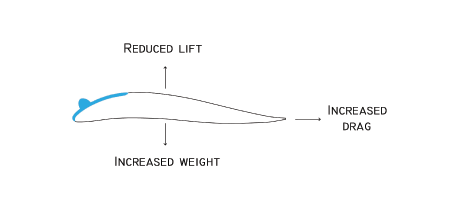by Andrea Cristofaro and Tor Arne Johansen
In unmanned aerial vehicles, it is vital to be able to detect and accommodate ice adhesion on wings, control surfaces and airspeed sensors, since ice accretion modifies the shape of the aircraft and alters its measurements, thus changing the aerodynamic forces and reducing manoeuvring capability.
The use of unmanned aerial vehicles (UAVs) for civil applications – largely surveillance and monitoring - has increased markedly in recent years. UAVs are very often suited for harsh conditions that are unsafe for humans, such as those typically encountered in Arctic operations. Reliable, appropriate, and efficient UAV operations are needed in such conditions.
The phenomenon of ice accretion on aircraft wings and control surfaces is a well recognized problem in aerospace engineering: the modified shape of the leading edge due to ice, changes the lift, drag and pitch moment characteristics of the wing. For instance, an ice-covered airfoil may experience a 40% reduction in lift coefficient, while the drag may be increased by as much as 200%. A decrease in lift requires more engine power and implies a premature airfoil stall angle.
Large aeroplanes are commonly equipped with efficient anti-icing and de-icing devices; however, these are largely unsuitable for small aircraft, owing to their simple architecture and limited payload. Ice formations on aircraft surfaces during flight are typically caused by supercooled water droplets (SWD). When a water droplet cools, it does not freeze until it reaches a very low temperature; however, a droplet will freeze instantly, releasing latent and accreting ice, when it interacts with an external agent such as an aircraft,. Both rate and amount of ice depend on the shape of the surface, its roughness, travelling body speed, temperature and droplet size.

Figure 1: Ice accretion effects on airfoils.
A first challenge is the in-flight detection of icing, i.e., recognizing the accretion of ice layers using data provided by onboard sensors. This problem can be addressed by applying the results of a recent study by our research team [1],[2], in which we proposed a scheme for fault detection and isolation in overactuated systems based on Unknown Input Observers and Control Allocation methods. Unknown Input Observers are deterministic estimators that can be made insensitive to unmeasured inputs, while Control Allocation is very well suited to handle constraints and to readily reconfigure the control action in spite of actuator failures. Combining these two methods, a procedure has been designed to keep icing effects decoupled from mechanical faults and external disturbances such as wind gusts [3].
A second step towards achieving icing protection for UAVs, is the implementation of an efficient anti-icing and de-icing mechanism. Very promising results come from carbon nanotechnology that can be used to make thin films of coating material to be painted on aircraft wings. Using the electricity onboard, the film can be heated to melt the ice. Such devices, however, are very energy demanding, thus it is vital to have an optimal scheme for the activation of the de-icing system to maintain aircraft stability. The combination of the aircraft dynamical model and the model describing the accretion of icing is the ‘Stefan problem’, which consists of a set of four partial differential equations: two heat equations, one mass balance equation and one energy balance equation.
Finally, in order to test and validate the efficiency and robustness of the icing detection algorithms as well as the icing protection module, field experiments in Svalbard are planned for the near future using the X8 UAV (Skywalker Technology Co, Ltd.).
The research at NTNU is a fruitful collaboration with other two ERCIM partner institutes, namely University of Porto (UPT) and University of Cyprus (UCY). In particular, we are currently working jointly with Prof. Pedro Aguiar (UPT) and Prof. Marios Polycarpou (UCY) who have made outstanding contributions to the project with their expertise in multiple model adaptive estimation and nonlinear fault detection, respectively.
References:
[1] A. Cristofaro, T. A. Johansen: “Fault-tolerant Control Allocation: An Unknown Input Observer based approach with constrained output fault directions”, in proc. of the 52nd IEEE Conf. on Decision and Control, Florence, Italy, 2013, pp. 3818-3824.
[2] A. Cristofaro, T. A. Johansen: “Fault-tolerant control allocation using Unknown Input Observers”, Automatica, 50(7), 2014, pp. 1891-1897.
[3] A. Cristofaro, T. A. Johansen: “An Unknown Input Observer approach to icing detection for unmanned aerial vehicles”, accepted for publication in proc. of IEEE American Control Conference 2015.
Please contact:
Andrea Cristofaro
ERCIM post-doc fellow at NTNU, Norway
E-mail:
Tor Arne Johansen, NTNU, Norway
E-mail:











